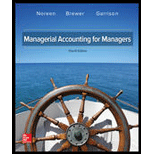
1a.
To prepare: A contribution format income statement showing both dollar and percentage for each product and for the company as whole.
Introduction:
Break-even point:
Break-even point is the point at which there is no
1b.
To compute: The company’s break-even point in dollar sales and to calculate its margin of safety in dollars and percentage.
Introduction:
Break-even point:
Break-even point is the point at which there is no profit or no loss because at this point the total cost is equal to the total sales revenue generated by the company. The contribution earned by the company is sufficient to cover all its costs at the break-even point and if the contribution is lesser then it is loss and if it is higher, then it is profit.
2a.
To prepare:A revised contribution format income statement that includes Samoan delight assuming that the sales of the other two products does not change.
Introduction:
Break-even point:
Break-even point is the point at which there is no profit or no loss because at this point the total cost is equal to the total sales revenue generated by the company. The contribution earned by the company is sufficient to cover all its costs at the break-even point and if the contribution is lesser then it is loss and if it is higher, then it is profit.
2b.
To compute: The company’s revised break-even point in dollar sales and to calculate its revised margin of safety in dollars and percentage.
Introduction:
Break-even point:
Break-even point is the point at which there is no profit or no loss because at this point the total cost is equal to the total sales revenue generated by the company. The contribution earned by the company is sufficient to cover all its costs at the break-even point and if the contribution is lesser then it is loss and if it is higher, then it is profit.
3.
To explain: the reason to the president for a higher break-even point even though the contribution margin has increased with the addition of new product.
Introduction:
Break-even point:
Break-even point is the point at which there is no profit or no loss because at this point the total cost is equal to the total sales revenue generated by the company. The contribution earned by the company is sufficient to cover all its costs at the break-even point and if the contribution is lesser then it is loss and if it is higher, then it is profit.
Trending nowThis is a popular solution!

Chapter 3 Solutions
Managerial Accounting for Managers
- Please help me with this questionarrow_forwardPlease provide the accurate answer to this general accounting problem using valid techniques.arrow_forwardGiven the following information how much raw material was transferred to work in progress on March 31? Inventory on March 1 is $420,000, raw materials purchased in March are $735,000, and raw materials inventory on March 31 is $185,000. A: $890,000 B: $970,000 C: $780,000 D: $955,000arrow_forward
- Which of the following is a characteristic of a perpetual inventory system? a. Inventory records are updated continuously b. Cost of goods sold is calculated at the end of the period c. Inventory is only counted at year-end d. Physical counts are never required MCQarrow_forwardReynolds corporation shipped out an order on March 10th (FOB destination) for a total of $21,450.75.arrow_forwardI want the correct answer with accounting questionarrow_forward

 AccountingAccountingISBN:9781337272094Author:WARREN, Carl S., Reeve, James M., Duchac, Jonathan E.Publisher:Cengage Learning,
AccountingAccountingISBN:9781337272094Author:WARREN, Carl S., Reeve, James M., Duchac, Jonathan E.Publisher:Cengage Learning, Accounting Information SystemsAccountingISBN:9781337619202Author:Hall, James A.Publisher:Cengage Learning,
Accounting Information SystemsAccountingISBN:9781337619202Author:Hall, James A.Publisher:Cengage Learning, Horngren's Cost Accounting: A Managerial Emphasis...AccountingISBN:9780134475585Author:Srikant M. Datar, Madhav V. RajanPublisher:PEARSON
Horngren's Cost Accounting: A Managerial Emphasis...AccountingISBN:9780134475585Author:Srikant M. Datar, Madhav V. RajanPublisher:PEARSON Intermediate AccountingAccountingISBN:9781259722660Author:J. David Spiceland, Mark W. Nelson, Wayne M ThomasPublisher:McGraw-Hill Education
Intermediate AccountingAccountingISBN:9781259722660Author:J. David Spiceland, Mark W. Nelson, Wayne M ThomasPublisher:McGraw-Hill Education Financial and Managerial AccountingAccountingISBN:9781259726705Author:John J Wild, Ken W. Shaw, Barbara Chiappetta Fundamental Accounting PrinciplesPublisher:McGraw-Hill Education
Financial and Managerial AccountingAccountingISBN:9781259726705Author:John J Wild, Ken W. Shaw, Barbara Chiappetta Fundamental Accounting PrinciplesPublisher:McGraw-Hill Education





